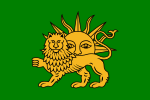Karabakh Beylarbeylik
| Karabakh Beylerbeylik | ||||||||||
| Qarabağ Bəylərbəyliyi | ||||||||||
| ||||||||||
|
| ||||||||||
| Capital | Ganja | |||||||||
| Government | Absolute monarchy | |||||||||
| History | ||||||||||
| • | Established | 1501 | ||||||||
| • | End of Safavid Empire | 1737 | ||||||||
| • | Disestablished | 1747 | ||||||||
| ||||||||||
| Today part of | | |||||||||
| Warning: Value not specified for "continent" | ||||||||||
Karabakh Beylarbeylik was an administrative region within the Safavid dynasty of Iran.[1] At the time of the Safavid Iran state, the entire territory of Arran was made up of three regions beylerbeydoms: Shirvan, Karabakh (or Ganja), Chukhursaad (or Iravan).[2] These regions were headed by the shah’s governors-general, who were called beylerbeys, or at other times hakems.
The first Safavid governor of Karabakh (hakem) was Piri Beg Qajar, and was appointed as such in 1501.[3] Shahverdi-Sultan, from the Ziyad-oglu clan of the Turkic Qajar tribe, was appointed by Shah Tahmasp I (r. 1524-1576) in 1554.[3] The nobility of the tribe was granted pastures and land plots in Karabakh.[4] The power of the Karabakh beylarbeys covered a vast territory – from the Georgian border near “Sinig Korpu” Bridge (currently “Red Bridge”) to Khudafarin Bridges on the Aras River.[5]
References
- ↑ Jackson, Peter. "Beglerbegī". Encyclopaedia Iranica. Retrieved 23 November 2012.
- ↑ Rahmani A. A. Azerbaijan in the late 16th and 17th centuries (1590–1700). Baku, 1981, pp. 87–89
- 1 2 Floor 2008, p. 258.
- ↑ A collection of articles on the history of Azerbaijan, edition 1, Baku, 1949, p. 250
- ↑ Mirza Adigozal-bey, Karabakh-nameh, Baku, 1950, p. 47
Sources
- Floor, Willem M. (2008). Titles and Emoluments in Safavid Iran: A Third Manual of Safavid Administration, by Mirza Naqi Nasiri. Washington, DC: Mage Publishers. ISBN 978-1933823232.
